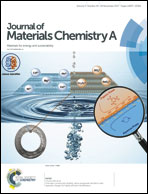Fabrication of microporous polymers for selective CO2 capture: the significant role of crosslinking and crosslinker length†
Abstract
Owing to their high physicochemical stability, low skeletal density, tailorable surface properties, and high porosity, microporous crosslink polymers are highly promising for selective CO2 capture, separation, and storage. The crosslinking (CL) and crosslinker length (CLL) in a polymer play a quite significant role in enhancing selective CO2 capture. To investigate the role of CL and CLL, polymers with no crosslinking (non-crosslinking, NCL), and small-(SCL), and long-crosslinker lengths (LCL) were successfully fabricated. It is noteworthy that the polymer containing SCL has remarkable CO2 adsorption capacity and selectivity over the polymer with LCL and NCL. High selectivity for CO2 over CH4/N2 was observed in the sequence SCL > LCL > NCL. This indicates that not only CL but CLL is also significantly important in generating highly efficient adsorbents. The adsorption capacity reaches 208.3 mg g−1, which is higher than that of the benchmarks including activated carbon (122.8 mg g−1), and 13X zeolite (180.3 mg g−1), as well as most reported carbon-based adsorbents. The CO2/N2 and CO2/CH4 selectivity reaches 541.4 and 64, respectively. Moreover, excellent recyclability was observed without loss in CO2 adsorption for 10 cycles. Thus, high CO2 capture, excellent selectivity, and high recyclability under energy-saving mild regeneration conditions make microporous polymers a unique adsorbent for selective CO2 capture from flue gas and natural gas.



 Please wait while we load your content...
Please wait while we load your content...